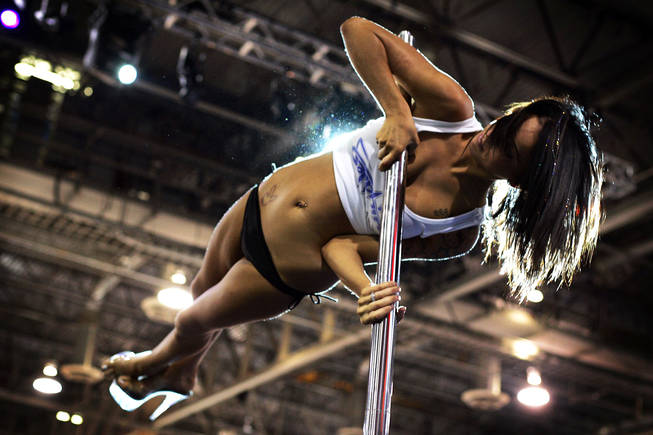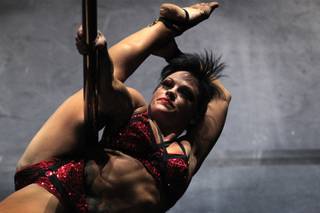
Alex from Sapphire Gentlemen’s Club competes in the pole dancing competition at the AVN Adult Entertainment Expo at the Sands Convention Center in Las Vegas on Friday, Jan. 7, 2011.
Friday, Sept. 6, 2013 | 2 a.m.
If Fawnia Dietrich gets her way, the 2016 Olympic Games will come equipped with a stage anchored by two poles — one that spins and one that doesn’t.
The Las Vegas pole fitness instructor is pushing to make pole dancing an Olympic sport. An online petition, sponsored by Vertical Dance and Labfitness, has more than 7,000 signatures.
It has been a tough sell trying to get the International Olympic Committee to recognize pole dancing as a legitimate sport.
"We haven't convinced them yet," said Dietrich, founder of Las Vegas' Pole Fitness Studio and the mastermind behind the Pole Expo taking place this weekend.
More than 1,200 pole fitness enthusiasts stormed the Palms to attend pole dancing workshops and compete. The expo runs through Sunday.
Pole Expo information
When: Sept. 5-8
Where: The Palms
Time: 9 a.m. – 5 p.m.; The Pole Classic and Pole Star Showcase starts 7 p.m. today.
Cost: $99 for a weekend pass; $39 for a day pass; $39 to enter a contest.
Dietrich hopes it will help her Olympic campaign.
"Pole dancing has been taught for almost 20 years," Dietrich said. "Most people dance because it's fun ... and empowering."
The practice demands a physical fitness that in many ways resembles Olympic training.
"Some of them come in here, and you're just like, 'God, I wish I had your arms,'" said chiropractor Kintara Oku, who treats Dietrich and other local pole dancers. "It's like swimming. When you swim, you're using all of your muscle groups. It's an unbelievable exercise."
Oku treats male pole dancers, as well — mostly former gymnasts looking for a new sport. The chiropractor says women tend to be better pole dancers because they're more flexible.
But even good flexibility can't prevent injuries.
Many of Oku's patients come to him with injured rhomboid muscles, which are attached to the spine just below the neck. The muscles retract the shoulder blade.
Oku sees arm and leg injuries, too.
Inverted moves require lots of shoulder strength. Dancers also regularly depend on their hands, calves, hamstrings, abs and bottoms. Posture and a good grip are key elements.
Oku most often prescribes stretches to help heal and maintain a muscle group or ligament.
"The old adage is true: use it or lose it," he said.
Oku also wouldn't be surprised if pole dancing eventually does make its way into the Olympics.
"They do stuff on the stage that amazes you," Oku said.
•••
Want to know more about pole dancing? Here are some facts about the ancient art:
• Pole dancing isn't just for women.
The proliferation of pole dancing fitness classes over the past decade has made the practice more acceptable for men and children. Some studios offer pole dancing classes for kids as young as 5. Male gymnasts also frequently pole dance to stay in shape.
• Pole dancing is a fusion of Chinese, Indian, Dutch and French dances.
The Indian sport mallakhamb, in which tricks are performed on a wooden pole, is believed to have originated in the 12th century and gained popularity in the 19th century.
Chinese pole dancers use two poles and hop from one to another. Their poles more closely resemble those used in pole dancing today but typically are covered in rubber to allow the performers to stick better.
Both sports are generally male dominated.
The circus dances got blended during the international shuffle of the Great Depression. Western pole dancing originated in the 1920s at traveling fairs, in which women would dance suggestively on a pole on small stages.
• Some poles spin.
Most clubs uses rotating poles. Spinning poles mean dancers need less strength to perform moves.
Dancers typically look more graceful, like figure skaters, when using rotating poles.
If pole dancing ever does become an Olympic sport, there likely would be categories for both spinning and stationary poles.


Join the Discussion:
Check this out for a full explanation of our conversion to the LiveFyre commenting system and instructions on how to sign up for an account.
Full comments policy